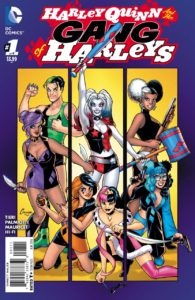
 Written by Jimmy Pamiotti & Frank Tieri
Written by Jimmy Pamiotti & Frank Tieri
Art by Mauricet
Letters by Dave Sharpe
Colours by Hi-Fi
Review by Billy Seguire
I’m still not entirely sure what Harley Quinn and Her Gang of Harleys was trying to accomplish in its first issue. Did it want to be a team-up book highlighting the strengths of varied characters? Did it want to bring in new readers by means of inclusion and diversity? Was it trying to make a statement about empowering women or modern culture? No. If it was honestly attempting any of these noble goals, I’m sorry to say that the effort was wholly unsuccessful. Somehow, Harley Quinn and Her Gang of Harleys #1 sends the worst message possible about its characters, expounding a tonally inappropriate and antiquated worldview so completely at odds with the mission statement of this book, that going in expecting anything other than a slap in the face seems hopelessly optimistic.
The concept of Harley Quinn spinning off with her own gang sounds like a fun ride. We’ve had books like Batman Incorporated before, books that, out of universe, exist because of modern readers’ desire to see new original characters interwoven into our favourite franchises. Not knowing much about this book going in, I assumed the premise of Harley Quinn and Her Gang of Harleys was going to be similar vehicle, with a new cast of characters supporting fan-favourite Harley Quinn. Sure, her costume has changed a few times too many, but as long as this new derby girl inspired version of Harley brought that special kind of crazy that’s made her work since Paul Dini’s creation of the character in Batman: The Animated Series, what could go wrong? The gang itself looked like a promising team, with a wide variety of viewpoints and personalities. Not only optimistic, I was excited about this book!
I was wrong. The Gang of Harleys in this comic is a group of caricatures at best. It calls Harlem Harley “just the right reality slap the gang needs” which, yes, means her character brings us the view from the streets. A believably asian character is described as being good at math. To add insult to injury, the genius in Harley Quinn herself has been all but snuffed out through consistently dismissive writing in a move that seems unsuccessfully designed to turn Harley Quinn into DC’s alternative to Deadpool. Instead, she’s a generic bimbo, reduced to pin-up status. Gone is the subversion and irony that came with Harley’s tight-fitting or skimpy wardrobe. A woman with a PhD in Psychiatry is now someone who takes a half a day to figure out Facetime and who we have to worry about falling in the toilet. Her kidnapping, the main plot of this book, is almost welcomed.
In the opening action of Harley Quinn and Her Gang of Harleys #1, the gang is seen beating the crap out of the Hipster Mafia. It’s a scene that fully illustrates the contempt the writers have for the current generation of adults in their 20s and 30s, a cheap joke that already feels ten years too late. Frustration at those flannel wearing, moustache grooming kids that sell handcrafted goods at street fairs, put into the mouths of a gang of kids living in the same generation. To make a further mess of things, one of the hipster characters starts talking after the fight about derogatory labels and culture shaming. The character, smiling up until that point, gets vengefully smacked in the face for their effort. It’s writing that makes me think the book is about to call me a social justice warrior by means of a slur. Are the writers tired of people telling them to be politically correct? Maybe there’s a reason people are trying to point out offensive attitudes in your speech.
The actual search for Harley is another story entirely. It could be a redeeming factor for these characters to band together, put their differences aside, and put their unique skills to work in the absence of our titular heroine to become something greater than they appear. The Gang of Harleys, however, spend this time carousing through pizza joints, dance clubs, zoos, and baseball games rather than actually looking for Harley in any way whatsoever. I get the joke, but it doesn’t change the fact that it’s weak storytelling. It’s the kind of team up where you feel like the characters are wasting their time almost as much as the writers are wasting yours.
The book is written by Jimmy Palmiotti and Frank Tieri. Without making it a personal attack, I’d like to point out that both are white, male, and average out at an age of around fifty. How does a comic starring seven women end up in these hands? There are so many deserving female writers in this industry who would have been an asset, who would have understood this group of characters better and given them a voice that feels true. Does a comic starring a woman have to be written by a woman? No. But… it helps. Why is Harvey Quinn’s sexuality a character trait, while none of the girl’s sexualities are even addressed? Why do the values of a younger generation get dismissed, with a seeming criticism get responded to with a smack to the face? If the story was put in the hands of younger writers, female writers, writers of colour, or any combination of these adjectives I could foresee a book that empowered these characters rather than making fun of them. After reading this comic, I feel the way I do after someone has made an inappropriate joke and assumes that I’m going to join in: uncomfortable, unwanted, and betrayed.
Artistically, the book fits the standard groove that DC likes their books to fall into for mainline superhero fare. The costumed characters stand out, civilians are genuinely visually interesting, and the bright blue skies highlight the intended lighthearted atmosphere of Coney Island pretty well. On visual analysis alone, it actually isn’t all that offensive. I did have a huge problem with an opening full-page splash of Harley Quinn tied up in bondage. Did the character have to be restrained in such a way that she looks like a fetish model? No. It was more than a little disturbing to actually see her put in that position, and it spoke volumes about the viewpoint of the comic that the image was displayed with such grandeur at the beginning of the issue. Other than that low point, there thankfully wasn’t much else that I was forced to view as flagrantly pandering to the male gaze. Harvey Quinn has the skimpiest of outfits, although the book tries a little too hard to stress how “the girls all like it”.
VERDICT: Skip It. This book pretends to a part of the positive trend to bring more variety into comics, but its dependance on creators who can’t understand their characters on anything more than a basic level means a lot of the book fights against what it actually intends. Every non-white character is written with some element of caricature and the comic itself is a mouthpiece for tired, anti-PC agendas.
The saddest part is, the next time someone wants to make an all-girl supergroup the focus of a DC comic, the higher ups are likely going to turn it down because Harley Quinn and Her Gang of Harleys didn’t sell.



